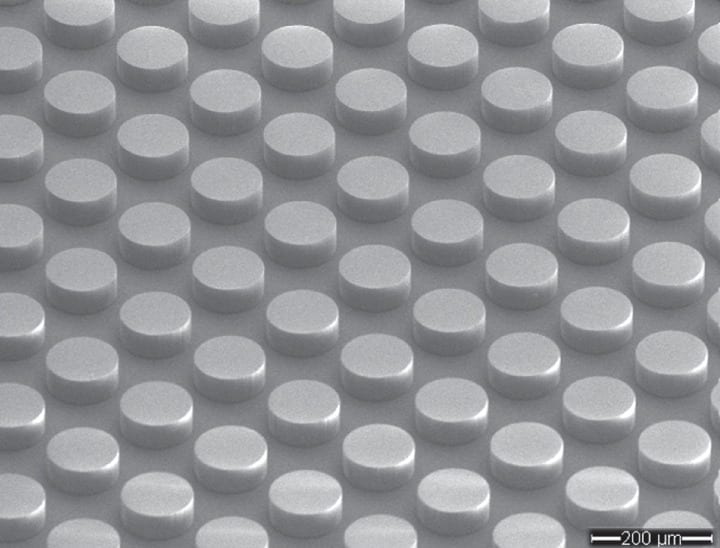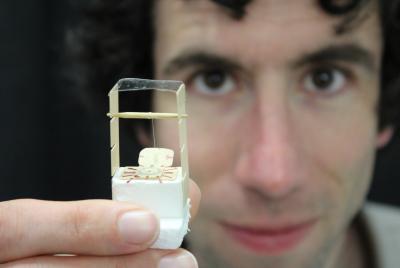
First demonstration of a metal-free metamaterial that can absorb electromagnetic energy
Electrical engineers at Duke University have created the world’s first electromagnetic metamaterial made without any metal. The device’s ability to absorb electromagnetic energy without heating up has direct applications in imaging, sensing and lighting.
Metamaterials are synthetic materials composed of many individual, engineered features that together produce properties not found in nature. Imagine an electromagnetic wave moving through a flat surface made of thousands of tiny electrical cells. If researchers can tune each cell to manipulate the wave in a specific way, they can dictate exactly how the wave behaves as a whole.
For researchers to manipulate electromagnetic waves, however, they’ve typically had to use electrically conducting metals. That approach, however, brings with it a fundamental problem of metals—the higher the electrical conductivity, the better the material also conducts heat. This limits their usefulness in temperature-dependent applications.
In a new paper, electrical engineers at Duke University demonstrate the first completely dielectric (non-metal) electromagnetic metamaterial—a surface dimpled with cylinders like the face of a Lego brick that is designed to absorb terahertz waves. While this specific frequency range sits between infrared waves and microwaves, the approach should be applicable for almost any frequency of the electromagnetic spectrum.
The results appeared online on Jan. 9 in the journal Optics Express.
“People have created these types of devices before, but previous attempts with dielectrics have always been paired with at least some metal,” said Willie Padilla, professor of electrical and computer engineering at Duke University. “We still need to optimize the technology, but the path forward to several applications is much easier than with metal-based approaches.”
Padilla and his colleagues created their metamaterial with boron-doped silicon—a non-metal. Using computer simulations, they calculated how terahertz waves would interact with cylinders of varying heights and widths.

A closer look at one of the cylinders comprising a new non-metal metamaterial. The arrows depict how different aspects of an electromagnetic field interact with the cylinder.
The researchers then manufactured a prototype consisting of hundreds of these optimized cylinders aligned in rows on a flat surface. Physical tests showed that the new “metasurface” absorbed 97.5 percent of the energy produced by waves at 1.011 terahertz.
Efficiently absorbing energy from electromagnetic waves is an important property for many applications. For example, thermal imaging devices can operate in the terahertz range, but because they have previously included at least some metal, getting sharp images has been challenging.
“Heat propagates fast in metals, which is problematic for thermal imagers,” said Xinyu Liu, a doctoral student in Padilla’s laboratory and first author of the paper. “There are tricks to isolate the metal during fabrication, but that becomes cumbersome and costly.”
Another potential application for the new technology is efficient lighting. Incandescent light bulbs make light but also create a significant amount of wasted heat. They must operate at high temperatures to produce light—much higher than the melting point of most metals.
“We can produce a dielectric metasurface designed to emit light, without producing waste heat,” Padilla said. “Although we’ve already been able to do this with metal-based metamaterials, you need to operate at high temperature for the whole thing to work. Dielectric materials have melting points much higher than metals, and we’re now quickly trying to move this technology into the infrared to demonstrate a lighting system.”
Learn more: Absorbing Electromagnetic Energy While Avoiding the Heat
[osd_subscribe categories=’electromagnetic-metamaterial’ placeholder=’Email Address’ button_text=’Subscribe Now for any new posts on the topic “ELECTROMAGNETIC METAMATERIAL”‘]
The Latest on: Electromagnetic metamaterial
[google_news title=”” keyword=”electromagnetic metamaterial” num_posts=”10″ blurb_length=”0″ show_thumb=”left”]
via Google News
The Latest on: Electromagnetic metamaterial
- News tagged with electromagnetic waveson May 8, 2024 at 5:00 pm
In the 1880s Heinrich Hertz discovered that a spark jumping between two pieces of metal emits a flash of light—rapidly oscillating electromagnetic waves—which can be picked up by an antenna.
- Team demonstrates an ultra-broadband tunable terahertz absorber of graphene and hierarchical plasmonic metamaterialson April 1, 2024 at 12:56 pm
Optical metamaterial is an effective approach ... tunable metamaterials can dynamically manipulate electromagnetic waves, improving multidimensional control of the optical response.
- New carbon-based tunable metasurface absorber paves the way for advanced terahertz technologyon January 19, 2024 at 7:24 am
patterned microstructures with unique electromagnetic properties in the THz range, providing unprecedented control over signals at these frequencies. Although various 2D metamaterial (or ...
- electromagnetic fieldon August 30, 2022 at 5:00 pm
Earlier this year we made the journey to a field in the West of England for the Electromagnetic Field hacker camp. It was the usual few days of fun in the open air, but due to a few technical ...
- Electromagnetic spectrumon November 16, 2021 at 3:31 pm
It was Scottish physicist James Clerk Maxwell who proposed that these charges were exerting influence through the form of radiation, so-called electromagnetic waves, which he proved were ...
- Review: What On Earth Is An Electromagnetic Radiation Tester And Why Would I Need One?on April 7, 2021 at 12:11 am
So it is with today’s subject, a Mustool MT525 electromagnetic radiation tester. At a cost not far above £10 ($13.70), this was an impulse purchase driven by curiosity; these devices claim to ...
- Metamaterials and Metasurfaces: Engineered Structures Revolutionizing Light and Matter Interactionson August 18, 2020 at 1:09 pm
These nano structures take gold from a conventional material to a metamaterial. And although nothing about the gold’s chemical properties have changed, we could now be seeing it as blue or red. You ...
- Dr Rola Saadon July 31, 2020 at 5:28 am
My EPSRC funded research project was focused on the design and modelling of miniaturised multiband electromagnetic periodic metamaterial structures for small antenna applications. Prior to my PhD, I ...
- Akim Akyurtluon August 3, 2019 at 2:03 pm
(Principal) Phase I N09-T018, Electromagnetic Metamaterial Films (2009), Contract - OFFICE OF NAVAL RESEARCH Akyurtlu, A. (Principal) Spray-Coatable Metamaterials for Use as Narrow Bandpass Filters ...
via Bing News











